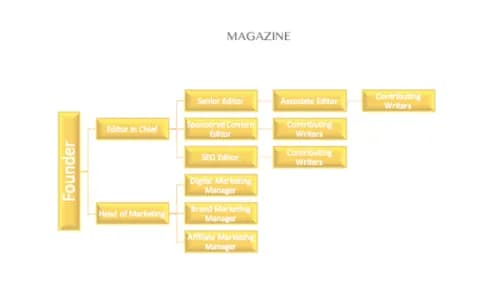Org Chat: Examples, Explanation and How to Create One
Building a company org chart, also known as an organization chart, an organizational chart or a hierarchy chart, but not sure where to start? Here's everything you need to know to create an org chart that accurately depicts the organizational structure of your company — and some example charts to inspire your own.
What is an org chart?
An org chart, simply, is a graphical representation of your organization's structure. In short, an org chart is purposefully designed is to illustrate the relationships and relative ranks of the job positions within your organization.
Most traditional org charts will depict one of four main organizational structures since most organizations tend to fall into one of these categories. So, what are the four types of organizational structures?
- The Flat Structure
- The Functional Structures
- The Divisional Structure
- The Matrix Structure
1. Flat Structure
A flat structure, also known as a flatarchy, refers to a very specific type of organization that is increasingly popular among growing startups and smaller organizations. It removes unnecessary hierarchal levels and spreads power across the organization.
“Unlike the traditional hierarchy which typically sees one-way communication and everyone at the top with all the information and power, a ‘flatter’ structure seeks to open up the lines of communication and collaboration while removing layers within the organization,” explains Forbes’Jacob Morgan.
2. Functional Structure
A functional structure, also known as a bureaucratic organizational structure, refers to a structure that includes undertakings such as supervision, management, direction and the allocation of responsibilities. It divides the company based on specialty. A traditional business with a sales department, a marketing department, a customer service department and more would fall into this category.
"The advantage of a functional structure is that individuals are dedicated to a single function," according to All Businss. "These clearly defined roles and expectations limit confusion. The downside is that it’s challenging to facilitate strong communication between different departments."
3. Divisional Structure
A divisional structure, also known as a product structure, refers to an arrangement of a business that breaks down into separate, self-oriented groups of functionalities that focus on different products or projects. An example company with a divisional structure is Gap, which boasts three different retailers underneath the umbrella company: Gap, Old Navy and the Banana Republic, all of which operate as individual companies but are, ultimately, under one brand.
4. Matrix Structure
A matrix structure refers to a more complex structure that bonds employees by both function and product. The matrix structure is a bit more nuanced in that employees have multiple bosses and reporting lines. So not only do they report to their divisional managers, but they also typically report to people like project managers.
What is the purpose of an org chart?
An org chart intends to depict your organization's structure so that human resources departments, employees and stakeholders can better understand the lay of the land.
For the human resource department, organization charts help HR representatives maintain the company's staff. When new hires come on board, they need to update the org charts. When people leave the company, the also need to update the org chart. This helps HR representatives to justify adding or reducing headcount, as well as to work with employees who are seeking opportunities to shift job roles.
For the new hires, the organization chart can be a lifeline that helps them to learn the names and titles of their new colleagues. It will also help them to understand where they fit into the overall structure of the company. Meanwhile, employees of all stages can better foresee their futures at the company, as well.
And investors and other stakeholders can get a better grasp for how they foresee the company's visions coming to light by taking a look at all the moving parts. This will also help them determine whether or not they have faith in the company.
An org chart is, therefore, similar to a football team's playbook. It's a visual representation of where all the team players stand, how they operate and how everyone, together, will work toward a shared vision and the company's ultimate goals.
What is the downside of an org chart?
Some critics of organization charts sometimes suggest that these kinds of diagrams may paint misleading pictures of a company structure. For example, they may wrongly imply the importance and influence of various positions within an organization and, as such, create an unnecessary hierarchy.
Likewise, some argue that org charts encourage employees to take a very narrow view of their job role. Since they see themselves as fitting into one place in the organizational structure, this can lead to employees pigeon-holing themselves.
And, lastly, some detractors point out that organization charts fail to recognize informal lines of communication and influence that are, often, equally as important in business settings. This becomes especially true when or if employees start cutting those lines of communication because they're not in their job descriptions.
How do you create an organizational chart?
You might be wondering, how do I create an org chart in Excel, for example. Creating an org chart is simple, though it may be time-consuming depending on how big your company is or nuanced your company structure is.
If you want to create an org chart in Excel, you can create a SmartArt graphic that uses an organization chart layout, such as "Organization Chart," or you can use Microsoft Visio to create an organization chart.
Here are the basic steps, according to Microsoft:
- On the Insert tab, in the Illustrations group, click SmartArt.
- In the Choose a SmartArt Graphic gallery, click Hierarchy, click an organization chart layout (such as Organization Chart) and then click OK.
- To enter your text, do one of the following:
- Click in a box in the SmartArt graphic, and then type your text.
- Click [Text] in the Text pane, and then type your text.
- Copy text from another location or program, click [Text] in the Text pane, and then paste your text.
Here's an example organizational chart created in Microsoft to give you some inspiration. This is a very basic look at how a new magazine might be structured:

Don’t miss out on articles like these. Sign up!
--
AnnaMarie Houlis is a feminist, a freelance journalist and an adventure aficionado with an affinity for impulsive solo travel. She spends her days writing about women’s empowerment from around the world. You can follow her work on her blog, HerReport.org, and follow her journeys on Instagram @her_report, Twitter @herreportand Facebook.
Why women love us:
- Daily articles on career topics
- Jobs at companies dedicated to hiring more women
- Advice and support from an authentic community
- Events that help you level up in your career
- Free membership, always
